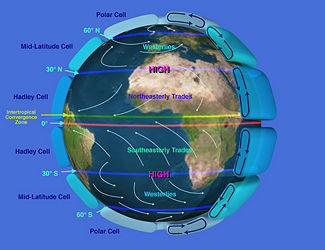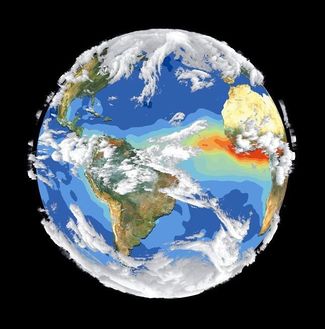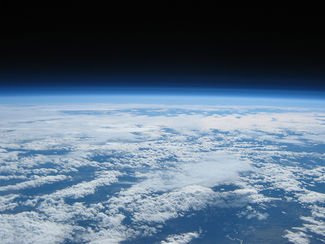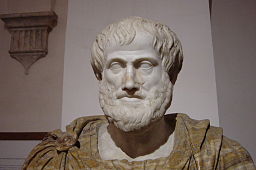Meteorology
 From Citizendium - Reading time: 4 min
From Citizendium - Reading time: 4 min

The six global cells of air circulation.

Composite satellite photos of Earth.

Approximately 100,000 feet above Oregon.
Meteorology is the interdisciplinary scientific study of the processes and phenomena of the atmosphere, including weather studies and forecasting.[1][2]
Meteorological phenomena are observable weather and other events which are explained by the science of meteorology. Those events are bound by the variables existing in Earth's atmosphere (such as temperature, pressure and water vapor) and their gradients, interactions and how they vary with time.
Meteorology, climatology, atmospheric physics, and atmospheric chemistry are sub-disciplines of the atmospheric sciences, which in turn is a sub-discipline of Earth science.
Categories and sub-disciplines of meteorology[edit]
Meteorology has certain major categories, including but not limited to:
- Boundary layer meteorology: The study of processes in the atmospheric layer directly above Earth's surface, known as the atmospheric boundary layer (ABL)[3]
- Mesoscale meteorology: The study of atmospheric phenomena within a vertical scale that starts at the Earth's surface and includes the atmospheric boundary layer, the troposphere, the tropopause, and the lower section of the stratosphere. The majority of Earth's observed weather is in the troposphere.[4]
- Physical meteorology: The study of physical aspects of the atmosphere such as rain, thunderstorms, pressure fronts, hurricanes, tornadoes, etc.
- Synoptic meteorology: The analysis and forecast of large-scale weather systems.
- Dynamic meteorology: Focuses on the theoretical laws of physics pertaining to the atmosphere.
Meteorology also has many specialized sub-disciplines such as:
- Weather forecasting: The application of science and technology to predict the state of the atmosphere for a given location at a given time.
- Aviation meteorology: The study of the effects of weather conditions on the control of air traffic.
- Agricultural meteorology: The study of the effects of weather and climate conditions on everything related to agriculture.
- Hydrometeorology: A combination of hydrology and meteorology which focuses on things such as the hydrologic cycle and the water budget as well as forecasts and statistics of heavy rainfall and heavy snow storms.
- Atmospheric chemistry: A branch of atmospheric science in which the chemistry of the Earth's atmosphere and that of other planets is studied.
- Air pollution dispersion modeling: The mathematical simulation of how air pollutants disperse in the ambient atmosphere. It is performed with computer programs, called dispersion models, that solve the mathematical equations and algorithms which simulate the pollutant dispersion.
- Nuclear meteorology: Studies of the distribution of radioactive substances in the atmosphere.
- Maritime meteorology: Deals with wind and wave forecasts for ships operating at sea.
Meteorologists[edit]
Meteorologists are scientists who study meteorology. Meteorologists work in government agencies, private consulting and research services, industrial enterprises, public utilities, radio and television stations, and in education.
Meteorologists are best known for forecasting the weather. Many radio and television weather forecasters are professional meteorologists, while others are merely reporters with no formal meteorological training. The American Meteorological Society and National Weather Association issue "Seals of Approval" to weather broadcasters who meet certain requirements.
Many professional meteorologists work in the field of air pollution dispersion modeling and air quality monitoring. The American Meteorological Society also bestows the title of "Certified Consultant Meteorologist" to such professionals who meet certain requirements.
History[edit]
The beginnings of meteorology in India can be traced back to ancient times. In fact, early philosophical writings of the 3000 B.C. era, such as the Upanishads (philosophical texts considered to be the source of the Hindu religion), contain serious discussion about the processes of cloud formation and rain and the seasonal cycles caused by the movement of Earth around the Sun.[5]

A marble bust of Aristotle.
It was the Greek philosopher and scientist Aristotle (384–322 BC) who was the first to use the word meteorology in his book Meteorologica (ca. 340 BC) which summarized the knowledge of that time about atmospheric phenomena. He wrote about clouds, rain, snow, wind, and climatic changes, and although many of his findings later proved to be incorrect, many were insightful.[6]
Although systematic recording of weather data began in about the fourteenth century, the lack of weather measuring instruments made only visual observations possible at that time. The real scientific study of atmospheric phenomena started later with the invention of devices to measure weather data: the thermometer in about 1600 for measuring temperature; the barometer for measuring atmospheric pressure in 1643 by Evangelista Torricelli (1608-1647), Italian mathematician and physicist, from an idea by Galileo Galilei (1564-1642); the anemometer for measuring wind speed in 1667; and the hair hygrometer for measuring humidity in 1780.
In 1793, John Dalton published a treatise on extensive meteorological observations in the area of Manchester, England, with a second edition in 1834, containing thousands of observations and establishing him as a pioneer meteorologist.[7] In 1802, the first cloud classification system was formulated, and in 1805, a wind scale was first introduced.
These measuring instruments and new ideas made possible gathering of actual data from the atmosphere giving the basis for scientific theories for properties of the atmosphere (pressure, temperature, humidity, etc.) and its governing physical laws.[6]
In the early 1840s, the first weather forecasting services started with the use of the telegraph to transmit meteorological information.
By the 1940s, upper-air measurements of pressure, temperature, wind and humidity clarified more about the vertical properties of the atmosphere. In the 1950s, radar became important for detecting precipitation over a remote area. [6]
In 1960, the first meteorological satellite was launched to provide 24-hour monitoring of weather events worldwide. These satellites now give three-dimensional data to high-speed computers for faster and more precise weather predictions. Computers still have their capacity limits and weather prediction models still contain many uncertainties.[6] Incidentally, investigations about these uncertainties led to the discovery, by Edward Norton Lorenz, of chaos as a property of some complex systems [8]. In this context, it is perhaps not surprising that many complicated issues remain at the forefront of meteorological research, including air pollution, climate change, ozone hole, and acid rain issues.
References[edit]
- ↑ W.K. Hamblin and E.H. Christiansen (2003). Earth's Dynamic Systems, 10th Edition. Prentice Hall. ISBN 0-13-142066-6.
- ↑ F.K. Lutgens and E.J.Tarbuck (1991). The Atmosphere: A Introduction to Meteorology, 5th Edition. Prentice Hall. ISBN 0-13-051475-6.
- ↑ J.R. Garratt (1994). The Atmospheric Boundary Layer. Cambridge University Press. ISBN 0-521-46745-4.
- ↑ Horace R. Byers (1974). General Meteorology, 4th Editions. McGraw-Hill. ISBN 0-07-009500-0.
- ↑ History of Meteorology in India.
- ↑ 6.0 6.1 6.2 6.3 Meteorology
- ↑ John Dalton. (1834) Meteorological Observations and Essays: By John Dalton. (Free Full-Text) Harrison & Crosfield, for Baldwin and Cradock, London.
- ↑ Lorenz, E.N. (1963), "Deterministic Nonperiodic Flow", Journal of the Atmospheric Sciences 20 (2): 130–141
 KSF
KSF